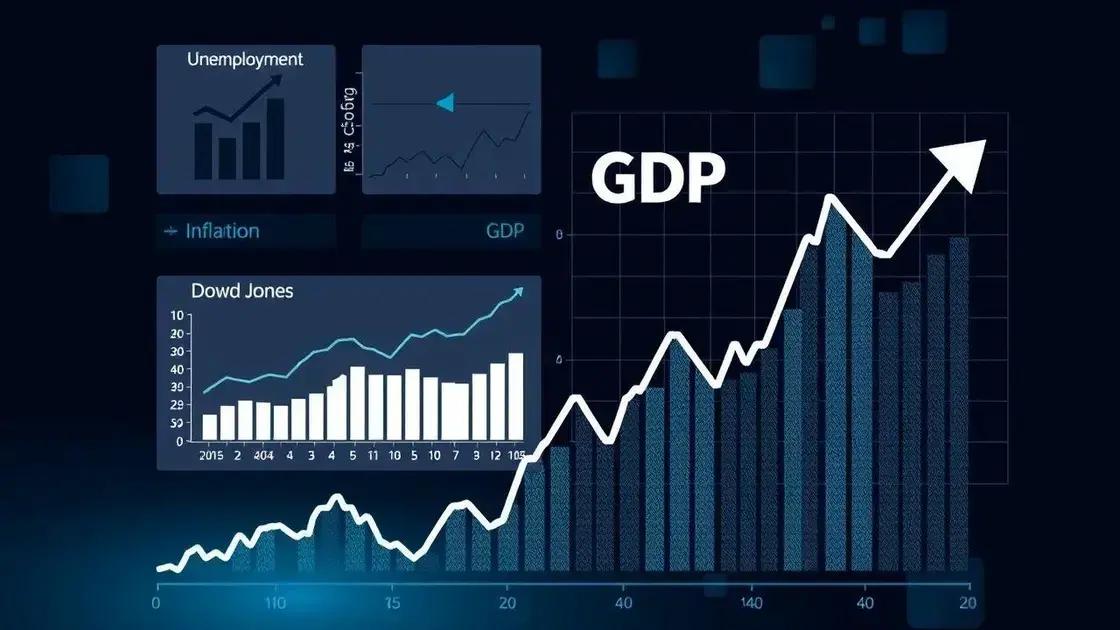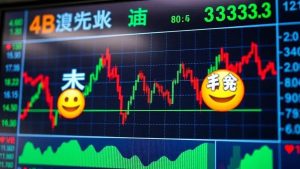Dow Jones fluctuations: what you need to know

Dow Jones fluctuations are influenced by economic indicators, investor sentiment, and global events, and can be managed through strategies like dollar-cost averaging and portfolio diversification.
Dow Jones fluctuations capture the attention of investors and analysts alike. These shifts can signal broader market trends, shaping financial strategies and investment decisions. Ever wondered how these changes affect your portfolio?
Understanding Dow Jones fluctuations
Understanding Dow Jones fluctuations is crucial for anyone interested in the stock market. It helps investors make informed decisions. When the Dow Jones increases or decreases, it affects various sectors in the economy.
What Causes Fluctuations?
There are several factors that can lead to fluctuations in the Dow Jones. Market sentiment, political changes, and economic reports play significant roles. For instance, positive news can boost investor confidence, while negative reports can create uncertainty.
Main Factors Influencing the Dow
- Economic Indicators: Reports such as GDP growth and unemployment rates impact fluctuations.
- Company Performance: Earnings reports from major companies in the index sway overall market sentiment.
- Global Events: International crises or trade agreements can influence Dow Jones trends.
- Investor Behavior: Market psychology can lead to panic selling or buying sprees.
When analyzing Dow Jones fluctuations, it’s also important to look at overall market trends over time. For example, during economic booms, the index usually climbs steadily. Conversely, during recessions, you can typically see severe drops. Understanding these patterns can help you anticipate future movements.
Historical Context
Watching historical trends can provide insights into how the Dow reacts to various situations. Look at key points in history, such as major recessions and recoveries, to grasp how external factors lead to price changes. This understanding can help investors better navigate future fluctuations.
Interpreting the Dow Jones fluctuations requires a blend of knowledge, strategy, and timing. Keeping abreast of the market news and understanding the economic climate will empower you to make better investment choices and adapt to the movements.
Factors influencing the Dow Jones

Understanding the factors influencing the Dow Jones is essential for investing wisely. Various elements can lead to its fluctuations, shaping market outcomes. By analyzing these factors, you can better prepare for changes in your investment strategy.
Key Factors
Several key factors can greatly influence the Dow Jones index. Economic conditions, investor sentiment, and global events all play significant roles. For instance, a rise in consumer confidence often leads to increased spending, which can push stock prices up.
Economic Indicators
- Interest Rates: Changes in interest rates can impact borrowing and spending.
- Inflation Rates: High inflation can erode purchasing power, affecting stock values.
- Employment Data: Job growth usually boosts market confidence.
- Gross Domestic Product (GDP): A strong GDP indicates a healthy economy and typically supports a rising stock market.
Investor behavior is another factor that significantly shapes the Dow. When investors feel optimistic, they tend to buy more stocks. This buying pressure can lift stock prices. Conversely, negative news often triggers panic selling, resulting in falling prices. Market sentiment can act as a self-fulfilling prophecy, where perceptions and reactions can lead to actual market changes.
Global Events
In addition to domestic factors, global events can have immediate effects on the Dow. International crises can lead to uncertainty, causing investors to withdraw from stocks. Trade agreements or disputes also affect market dynamics, as they influence company profits and economic growth.
As you observe the factors influencing the Dow Jones, remember that these elements are interconnected. Changes in one area can ripple through the entire market, affecting your investment choices.
Historical trends of the Dow Jones index
Examining the historical trends of the Dow Jones index provides valuable insights into market behavior. Understanding these trends can help investors make informed decisions and recognize patterns that may repeat over time.
Key Historical Events
Several significant events have shaped the trajectory of the Dow Jones. For instance, the Great Depression in the 1930s triggered a drastic decline in stock prices. This period taught investors about market risks and the importance of economic stability.
Long-Term Growth
Despite challenges, the long-term trend of the Dow Jones has been one of growth. Over the decades, as the economy expanded, the index generally trended upward. This growth reflects advancements in technology, productivity, and consumer spending. Investors have often seen the Dow as a benchmark for overall economic health.
Major Declines and Recoveries
- 2008 Financial Crisis: A significant decline occurred during this time, as housing markets collapsed and banks failed.
- COVID-19 Pandemic: In early 2020, the Dow saw sharp declines due to economic shutdowns worldwide.
- Market Recoveries: The index often rebounds after significant declines, demonstrating resilience and recovery in investor confidence.
- Technological Innovation: Factors like the rise of the digital economy have contributed to the upward trends observed in the long-term.
Understanding these patterns is critical when looking at the historical trends of the Dow Jones index. These trends not only provide context for current market conditions but also help investors anticipate future movements.
Impact of economic indicators

The impact of economic indicators on the Dow Jones is significant and multifaceted. These indicators provide vital information about the health of the economy and influence investor decisions. When economic indicators are released, they often sway market sentiments and can lead to immediate fluctuations in the index.
Types of Economic Indicators
Several key economic indicators are closely monitored by investors. Understanding these can help you gauge market conditions. Major indicators include unemployment rates, inflation rates, and Gross Domestic Product (GDP) growth. Each of these plays a crucial role in shaping economic outlooks.
Unemployment Rates
- Rising Unemployment: If joblessness increases, consumer spending often declines, leading to lower stock prices.
- Decreasing Unemployment: A drop in job loss usually signals economic recovery, positively affecting the Dow.
- Job Growth Trends: Consistent job growth may bolster investor confidence and push the index higher.
Inflation is another vital indicator impacting the Dow. When inflation rises, purchasing power falls, which can lead to uncertainty in the stock market. However, moderate inflation can signal a growing economy where companies may increase prices, maintaining profits. Investors often keep an eye on inflation reports to adjust their strategies accordingly.
Gross Domestic Product (GDP)
GDP is a comprehensive measure of economic activity. A growing GDP indicates a healthy economy, which is typically favorable for the Dow. Conversely, a shrinking GDP can lead to economic concerns, causing stock prices to drop. Monitoring GDP can provide insights into whether the stock market may experience upward or downward trends in the near future.
In summary, the impact of economic indicators is profound and can dictate the movement of the Dow Jones index. Recognizing how these indicators function allows investors to navigate market shifts more effectively and make informed decisions.
Strategies for investing during fluctuations
Implementing effective strategies for investing during fluctuations is crucial to maintaining and growing your investment portfolio. Market fluctuations can create uncertainty, but they also offer unique opportunities for savvy investors. Understanding how to navigate these changes can lead to financial success.
Dollar-Cost Averaging
This strategy involves regularly investing a fixed amount of money, regardless of the market conditions. By investing consistently, you purchase more shares when prices are lower and fewer shares when prices are higher. This approach helps reduce the impact of market volatility over time.
Defensive Stocks
Defensive stocks are shares in companies that tend to remain stable during market downturns. These companies typically provide essential goods or services, such as utilities or consumer staples. Investing in defensive stocks can help cushion your portfolio when fluctuations occur, providing some level of security.
Portfolio Diversification
- Spread Investments: Invest across various asset classes, such as stocks, bonds, and real estate.
- Geographic Diversification: Consider international investments to mitigate local economic downturns.
- Sector Diversification: Invest in different industries to reduce risk exposure.
- Regular Reviews: Continuously evaluate your portfolio to ensure it aligns with your long-term goals.
Staying informed about market trends is another essential strategy. Read financial news and analysis to keep yourself updated. This knowledge allows you to identify potential opportunities and adjust your investments accordingly. Moreover, maintaining a long-term perspective is vital during periods of volatility. Avoid making impulsive decisions based on short-term market movements; instead, focus on your overall investment goals.
Lastly, consulting with a financial advisor can provide personalized strategies tailored to your unique financial situation. They can help you navigate fluctuations and make informed decisions based on your investment timeline and risk tolerance.
Future outlook for the Dow Jones index

The future outlook for the Dow Jones index is a topic of great interest among investors and analysts. Understanding potential trends and factors affecting the index can help shape investment strategies. While it is impossible to predict the future with certainty, trends can provide insights into what might lie ahead.
Market Predictions
Analysts often make predictions based on current economic data and historical trends. For instance, if economic indicators show signs of growth, the Dow might continue to rise. Conversely, if signs of recession appear, investors may see declines. Monitoring key factors is essential for making informed decisions about the future.
Technological Advancements
Innovation and technology significantly influence the Dow Jones index. As new technologies emerge, companies in the index adapt and evolve. For instance, the growth of artificial intelligence and renewable energy may create new investment opportunities. Firms that embrace change tend to perform better, which can positively affect the index.
Global Economic Conditions
- Geopolitical Events: Events like trade agreements or international conflicts can impact the market.
- Interest Rates: Future changes in interest rates by central banks may affect borrowing costs and investment.
- Inflation Trends: Persistent inflation could change consumer spending patterns, impacting the index.
- Consumer Confidence: High consumer confidence often correlates with economic growth and rising stock prices.
Investors should also consider the impact of government policies on the Dow. Changes in regulations, tax policies, and fiscal measures can create new dynamics in the market. Staying informed about these changes helps investors make proactive adjustments to their portfolios.
In addition, sector performance can signal future trends for the index. Industries like technology and healthcare may lead the market during growth periods. Recognizing which sectors are thriving can give investors an edge in positioning their portfolios for potential growth.
In conclusion, understanding the Dow Jones fluctuations and the various factors that influence them is essential for anyone interested in investing. By keeping an eye on economic indicators, market trends, and global events, you can better prepare yourself for fluctuations and take advantage of potential opportunities. Strategies such as dollar-cost averaging, portfolio diversification, and focusing on defensive stocks can help manage risks. Looking ahead, it’s important to stay informed about market changes and adjust your investment strategies accordingly. This proactive approach will empower you to navigate the stock market with confidence.
FAQ – Frequently Asked Questions about Dow Jones Fluctuations
What causes fluctuations in the Dow Jones index?
Fluctuations in the Dow Jones can be caused by various factors including economic indicators, investor sentiment, and global events.
How can I invest during market fluctuations?
You can invest during fluctuations by using strategies like dollar-cost averaging, diversifying your portfolio, and focusing on defensive stocks.
Why are economic indicators important?
Economic indicators are crucial as they provide insights into the health of the economy and can influence market trends and investment decisions.
What can I do to prepare for future market changes?
To prepare for future market changes, stay informed about economic trends, adjust your investment strategies regularly, and consider consulting a financial advisor.






